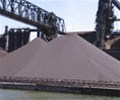Iron ore has emerged as the surprise in China’s first quarter commodity imports, with arrivals posting strong gains despite the gloom surrounding the key property construction sector.
March imports were 100.72 million metric tons, up 3.3% from February’s 97.51 million and just exceeding the 100.23 million from March 2023, according to official customs data released on April 12.
For the first quarter, the world’s biggest iron ore importer saw arrivals of 310.13 million tons, a gain of 5.5% over the same period a year earlier.
The strength in iron ore comes even as several property sector indicators remain soft, including broad credit growth, which rose at a record low pace in March, while new home prices fell at their fastest pace in more than eight years in March.
The robust iron ore imports also stand in contrast to the performance of another of China’s top commodity imports, namely .
Crude oil imports rose 0.7% in the first quarter to 137.36 million tons from the same period last year, equivalent to about 11.02 million barrels per day (bpd).
This was actually slightly weaker on a barrels per day basis, given the extra day in 2024 because of the leap year, with first quarter 2023 imports working out at 11.06 million bpd.
The market narrative surrounding oil demand in China, the world’s largest importer, has been fairly bullish, pointing to increasing air and road travel and some recovery in manufacturing.
The question for the market is how to resolve the dilemma of China’s strong iron ore imports with the ongoing weakness in the property sector.
One of the factors that has changed in the first quarter is that China’s portside inventories of the key raw material used to make steel have risen sharply.
Iron ore stockpiles, as monitored by consultants SteelHome rose to 143.6 million tons in the week to April 12.
This was the highest in 23 months and inventories are now up 37% from the seven-year low of 104.9 million tons, reached in the week to Oct. 27.
The question is whether the rise in stockpiles is due to anticipated strong demand, or a function of traders buying too much and being forced to hold inventories.
It’s most likely that demand expectations have been positive, as the rise in inventories has been sustained and constant in the past five months.
DELIBERATE STOCKPILING?
Another possible factor is China’s steel mills are trying to build a larger iron ore stockpile in order to give them some flexibility in trimming imports if they deem prices have risen too high, or too quickly.
This method of seeking to influence prices through using stockpiles is something that Chinese oil refiners and traders appear to have adopted in recent months.
Increases in the price of oil have resulted in softer imports some three months later, a period that reflects the lag between when crude is arranged and physically delivered.
Iron ore prices have trended weaker for most of 2024 so far, with Singapore-traded contracts sliding from a high of $143.60 a ton on Jan. 3 to a low of $98.36 on April 4.
The lower prices may be a factor behind the strength in imports, and it remains to be seen whether the recovery in prices since the April 4 low will result in imports pulling back.
Iron ore ended at $109.15 a ton on Monday, with the recent rally largely being built on hopes that Beijing will continue to roll out stimulus measures aimed at improving the health of the property sector.
So far, April imports look set to continue the recent strong run, with commodity analysts Kpler tracking arrivals of 100.18 million tons and LSEG data pointing to 96.29 million.
Both these estimates may rise prior to the end of the month as more cargoes are assessed as likely to arrive and offload.
For now, China’s solid iron ore story seems built on the fundamental of rising inventories, and the sentiment that steel demand will recover in the next few months as the world’s second-biggest economy gathers momentum.
Source: Hellenic Shipping News





